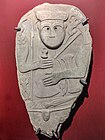Van Museum
Van müzesi | |
Archeological museum, Ethnographic museum | |
| Website | Van Museum |
|---|---|
The Van Museum or Urartu Museum (Turkish: Van müzesi) is a museum located in the city of Van in eastern Turkey. It showcases on 13,000 m2 a large archaeological and ethnographic record of human life and cultural development in the lake Van region from eastern Anatolia’s Stone Age to the present. The main focus of the museum is on the Urartian period, about 2800-2600 years ago. Of particular interest are the Hakkari kurgan stelae.[1]
History
The museum was founded in 1945. In 2011 it was affected by two earthquakes and a new building was constructed, located near the Van Fortress. It was opened to the public in 2019.[2]
Collection
The oldest archaeological items of the museum are from the
Among the artefacts from the Urartu kingdom, which originated in the 9th century BCE and became a civilisation that excelled in art, technology and metallurgy until its demise in the 6th century BCE, are weapons, everyday objects and
There is a large ethnographic collection of kilims and rugs but without mentioning the rich local Kurdish tradition of this craft.
-
Urartian stone inscriptions
-
God Teisheba on the bull, relief
-
Inscription Ayanis Fortress
-
Urartian war chariot
-
Seljuk tombs shaped as rams
Hakkari Stelae
Thirteen Kurgan stelae were found in 1998 in their original location at the centre of Hakkari. Eleven stelae depict armed warrior-men and two represent women without arms. The stelae were carved on upright flagstone-like limestone slabs measuring between 0.7 m to 3.10 m in height. The stones contain only one cut surface. Each stele features the fore view of an upper human body. The legs are not depicted.[5] The earliest stelae are in the style of bas relief while the latest ones are in a linear style. They were manufactured during a period from the 15th c. BCE to the 11th c. BCE in Hakkari.
The warrior-men, always holding a drinking vessel in their upraised right hand, are equipped with weapons and wear a dagger suspended on a belt. Remaining areas of the stelae are filled with small-sized animals or feature yurts of the Asian steppes thus indicating the nomadic or semi nomadic nature of a society that lived across this rugged landscape of Hakkari. Some stelae have both eyes inlaid.[6]
-
Unarmed woman
-
Warrior man equipped with weapons and tools. Both eyes are inlaid
-
Armed warrior man wearing a cap
-
Armed warrior man. Below his right elbow a woman figure
References
- ^ The collection of the Van Museum Retrieved 18 October 2023.
- ^ "Earth quake in eastern Turkey". CNN. 9 November 2011. Retrieved 2020-07-16.
- .
- ^ Van Museum's Urartian riches Retrieved 18 October 2023.
- ^ Antonio Sagona, The Heritage of Eastern Turkey: From earliest settlements to Islam (2006), pp. 68–71.
- ^ Veli Sevin, Mystery Stelae, Archaeology, Volume 53, Number 4, (July/August 2000).









